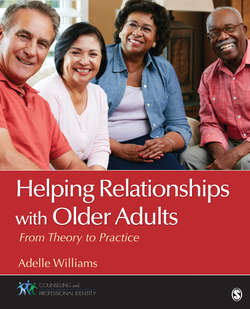Читать книгу Helping Relationships With Older Adults - Adelle M. Williams - Страница 24
На сайте Литреса книга снята с продажи.
Physical Changes That Accompany Aging
ОглавлениеAdulthood is a time of life characterized mostly by personal growth and stability, but over the adult life span, loss and decline begins (Heckhausen, 2001). Age-related declines in physical function are observed from midlife onward, even in the absence of disease, as a result of normal age-related changes in the musculoskeletal system and other body systems (Cooper, Kuh, & Cooper, 2011). It is important to remember that no two people age at the same rate. Levels of stability or decline differ greatly in areas of physical, sensory, and cognitive functioning.
Physically, some of the most noticeable signs of aging include the loss of pigmentation leading to the graying of hair, thinning of hair caused by hair germination center destruction, rigidity of the skin’s dermal layer leading to wrinkling, and changes in the strength and tone of voice (Whitbourne, 2001). Less noticeable signs of aging, which may affect most individuals in adulthood, include a decrease in bone density, decline in muscle mass, visual and auditory deterioration, changes in cardiovascular fitness and respiratory functioning, and changes in body regulation (e.g., decreased basal metabolism rates, endocrine and immune function, and sexual changes) (Masoro & Austad, 2001).
Typically, older people walk more slowly, have less muscle strength, have poorer memory and reasoning abilities, and are slower to respond on cognitive tasks relative to younger adults and to themselves when they were younger. Physical and cognitive functioning are both indicators of biologic aging. The aging process is often characterized by a loss of adaptive response to life challenges and an increasing vulnerability to pathology (i.e., aging-associated diseases) and functional limitations. However, biological aging is not tied absolutely to chronological aging. It may be possible to slow biological aging and even reduce the possibility of suffering from age-related diseases such as dementia (Peters, 2006). Many natural changes occur in the aging process, and the central nervous system is the major mechanism behind all changes.
